Various studies show that deforestation has increased at an alarming rate.1
Even as we combat climate change and other environmental factors like pollution, we need to view deforestation as a problem that needs to be checked.
Technological innovations are encouraging, and expansions are necessary, but this shouldn’t be at the expense of the ecosystem.
Deforestation is a problem for wildlife and, by extension, a problem for us too.
Several animals affected by deforestation include the pygmy elephant, Sumatran rhino, pandas, orangutans, chimpanzees, etc.
Deforestation is far more of a problem than we can imagine, and it extends beyond habitat loss for these animals.
Let’s find out more about this environmental menace.
What is Deforestation in Simple Terms?
Deforestation can be simply defined as the cutting down of trees, often not done accidentally.
These trees are chopped down to turn into the wood for the manufacturing sector.
NatGeo defines deforestation as the “purposeful clearing of forested lands,” which captures both the intent and the act.2
Contrary to what some people may imagine, deforestation is not a recent problem.
What is recent is how much it has increased. There used to be more forests in the world than there are now, and things don’t seem to have been ameliorated.
The statistics are staggering, and from 1990 earth has lost over 80 million forested lands.3
Though deforestation seems like it’s for a good cause, the loss of forests doesn’t come without consequences, especially for animals.
How Does Deforestation Affect Animals?
The major way deforestation affects animals is habitat loss.
Many creatures make forests their homes, and the reduction means the destruction of their living quarters.
This loss of habitat forces them out of their natural range and puts their survival at risk.
Other effects of deforestation include more competition amongst animals, an increased conflict with humans, loss of food and water, increasing natural disasters, and worsening climate change.
To better understand the effects, let’s delve deeper into the details. As we’ll see, they are interconnected:
Habitat loss
Animals are losing their homes with speed, and this is largely due to deforestation.
The trees and forests create a safe spot for birds to build nests and land animals to construct a living space.
The more trees go down, the fewer resources animals have to create shelter, feed, and thrive.
Some homeless creatures are forced to live in secondary forests that cannot satisfy their natural needs.
This leads to a shorter lifespan, and the long-term result is extinction.
Habitat loss also reduces genetic diversity, which is critical for a population adapting to environmental changes.4
Reproduction is affected, too, as animals dispersed by habitat loss might find it difficult to locate a mate.
These all put the affected creatures at risk of extinction.
Predation and competition
Because deforestation leads to the loss of forested land and—by extension—loss of resources, animals are forced to compete for the little they have left.
This could mean stealing prey, fighting over territories, or being in conflict over water.
Smaller animals and herbivores face the additional risk of predators, even new ones, when they find themselves in unfamiliar territory.
This is especially true if the predator is also suffering the effect of deforestation and is starving, which leads us to our next problem.
Starvation
Many animals feed on plants, and when those are taken away, they are left starving and without options.
Some, unfortunately, die as a result, while others move in search of better pastures.
Herbivores are prey to carnivorous animals, so when they for off or leave, these predators are affected. It’s a dangerous circle.
Conflict with humans
Deforestation serves in expanding human territory, and this inevitably leads to interactions with wildlife whose limited habitat becomes too close to the encroaching civilization.
This does more harm than good, even when the response from humans is positive.
Many creatures have a natural wariness for humans which reduces with further contact, increasing the chances of an attack.
Some animals also venture into farmlands in search of food, destroying crops.
These trespassers can lose their lives when farmers try to defend themselves.
Then we have car accidents that happen when these animals run into the highways, sometimes out of confusion.
Climate Change
Climate change is a distinct environmental issue, but there is a link between it and deforestation.
Trees store carbon dioxide, and when they are chopped down, this gas gets released alongside other greenhouse gases.5 6
If afforestation—the planting of trees—helps reduce climate change, then deforestation exacerbates it.
The greenhouse gases being released leads to high temperature and erratic weather changes, which can force animals to migrate to an area with a better climate.
Many animals also struggle to adapt to these weather changes.
Top 10 Animals Affected by Deforestation
Having known the effects of deforestation on animals, let’s see the ones that are more vulnerable to this.
1. Chimpanzee

- Scientific Name: Pan troglodyte
- Habitat: Savannah, forest
- Range: Africa
- Vulnerabilities: Human diseases
- IUCN Red List Status: Endangered
The chimpanzee is an African primate of the Hominidae family, also known as great apes.
The alternative name of the chimpanzee is the chimp. Because chimpanzees live in forests, they are victims of habitat loss due to deforestation.
Contact with humans also leaves them vulnerable to hunters and diseases.
Human disease is arguably the biggest problem facing chimpanzees in its range.
They are susceptible to more than 140 diseases, and because of their slow reproductive rate, it is hard to replace a dead individual.7
The chimpanzee is currently listed as endangered, which is a problem because of the role it plays in biodiversity.
2. Giant Panda
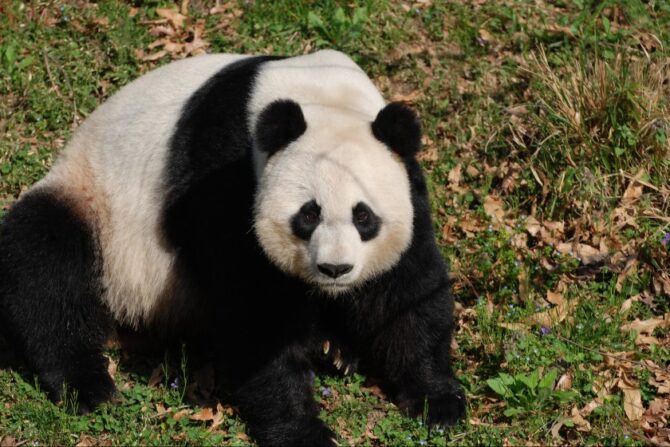
- Scientific Name: Alluropoda melanoleuca
- Habitat: Mountains
- Range: China
- Vulnerabilities: Habitat loss, fragmentation
- IUCN Red List Status: Vulnerable
The giant panda is a bear endemic to China, where it is considered the national animal.
It is easily recognized by its black-and-white coat, which distinguishes it from other bears.
Pandas used to live in lowland areas, but deforestation and some other human activities like farming moved them away.
They are now limited to mountain areas and conservation sites.
The great panda used to be classified as Endangered by the IUCN as there were only a few thousand left.
However, conservation efforts have proved to be successful, and the status has since changed to vulnerable.8
This doesn’t mean the panda is completely safe, however. More work needs to be done.
3. Monarch Butterfly
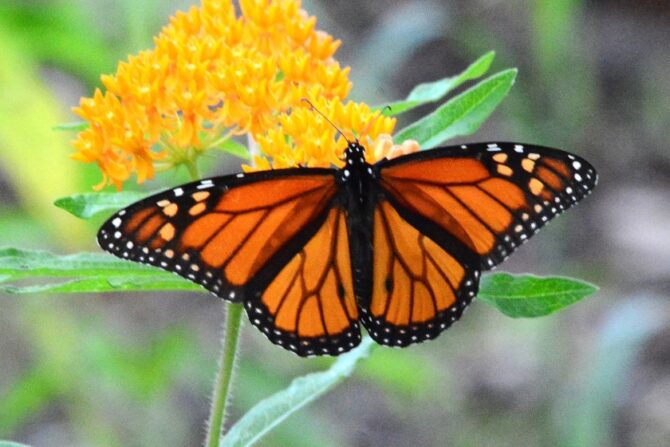
- Scientific Name: Danaus plexippus
- Habitat: Fields, pastures, gardens, residential areas
- Range: North America
- Vulnerabilities: Climate change
- IUCN Red List Status: Least Concern (entire species); Endangered (subspecies)
The monarch butterfly is a member of the family Nymphalidae and a native of North America, where it is one of the most common butterflies.
It is recognized both by its brown color and the migratory pattern.
Overall, the monarch butterfly as a species is still safe and classified as the Least Concern, but the migratory population is dwindling and classified as Endangered.
This is due to habitat loss and climate changes, both of which are effects of deforestation.
4. Orangutan
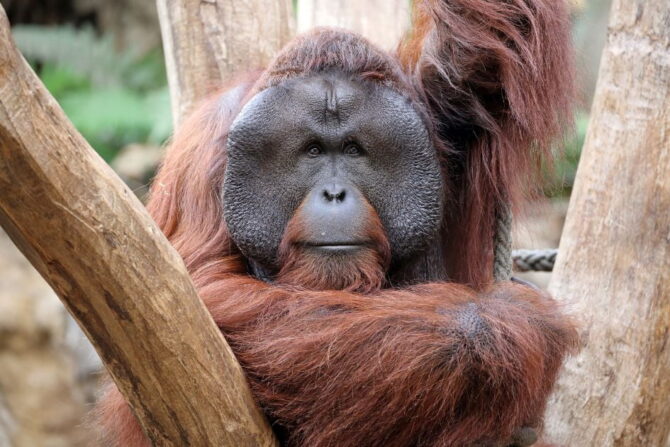
- Scientific Name: Pongo
- Habitat: Rainforest
- Range: Indonesia, Malaysia
- Vulnerabilities: Illegal hunting, deforestation
- IUCN Red List Status: Critically Endangered
The orangutan was once considered a species, but it has since been classified as three distinct species under the Pongo genus: The Bornean, Sumatran, and Tapanuli orangutan.
All three species are classified as critically endangered in Indonesia and Malaysia, the only places they can be found.
Orangutans used to be more widespread in Southeast Asia, but deforestation has dealt these creatures a strong hand.
This is largely due to the palm oil production and expansion of agriculture, and because there has been no control, it has continued unrestrained.
5. Pygmy Sloth

- Scientific Name: Bradypus pygmeaus
- Habitat: Red mangroves
- Range: Isla Escudo de Veraguas
- Vulnerabilities: Habitat destruction
- IUCN Red List Status: Critically Endangered
The pygmy sloth is a member of the Bradypopidae family, limited to the red mangrove of the Isla Escudo de Veraguas.
It is fully known as the pygmy three-toed sloth and also by the names dwarf sloth and monk sloth.
As its name implies, it is a small animal, the smallest of its genus.
This animal is classified as critically endangered by the IUCN, and deforestation has a huge hand to play in the dwindling population.
The sloth is arboreal and feeds on leaves, so the loss of trees on its island strips it of its meal source.
Sadly, the pygmy sloth is headed toward extinction. There are only around 100 left.
6. Sumatran Rhino
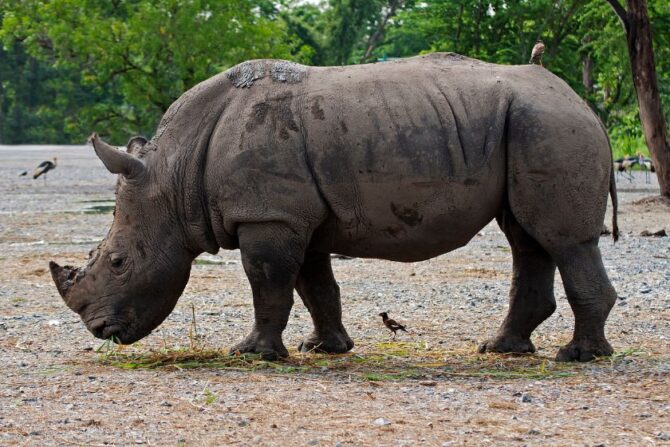
- Scientific Name: Dicerorhinus sumatrensis
- Habitat: Rainforest, swamps, cloud forests
- Range: Asia
- Vulnerabilities: Habitat loss, fragmentation
- IUCN Red List Status: Critically Endangered
The Sumatran rhino is fully known as the Sumatran rhinoceros. It also goes by the hairy rhinoceros and the Asian two-horned rhinoceros.
There are only five rhinoceros species, of which it is the smallest.
This doesn’t mean it is a small animal, however, as it still bears weight compared to other animals.
The Sumatran rhinoceros is rare because it is critically endangered.
Once found in many Asian territories like India, Bangladesh, Myanmar, and Laos, it is now confined to Sumatra (four populations) and Borneo (just one).
It has already started going extinct in these two last areas.
Habitat loss—thanks to deforestation—and poaching are the culprits.
7. Pygmy Elephant
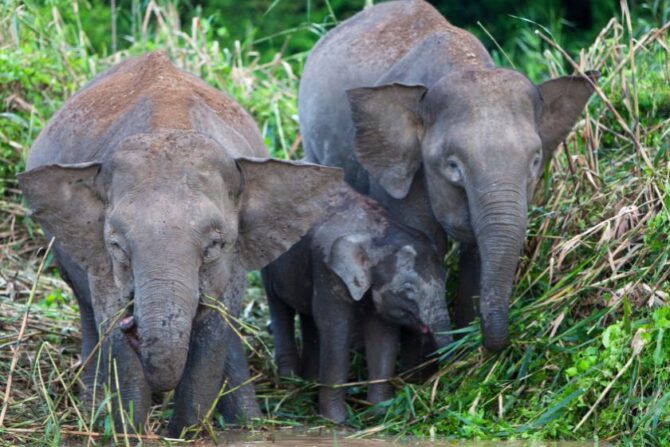
- Scientific Name: Elephas maximus borneesis
- Habitat: Lowland forests
- Range: Borneo
- Vulnerabilities: Habitat loss, fragmentation
- IUCN Red List Status: Endangered
The pygmy elephant is a subspecies of the Asian elephant, and it is also named the Borneo elephant based on its range.
Though a big animal on its right, it is the smallest elephant. Generally, Asian elephants tend to be smaller than African elephants, with the pygmy ranking as the smallest.
Unfortunately, this little elephant subspecies is sliding down to extinction.
Due to habitat loss caused by the destruction of lowland forests, the pygmy elephant has been classified as Endangered by the IUCN.
Its population has been further reduced by conflicts with animals.
8. Mountain Gorilla
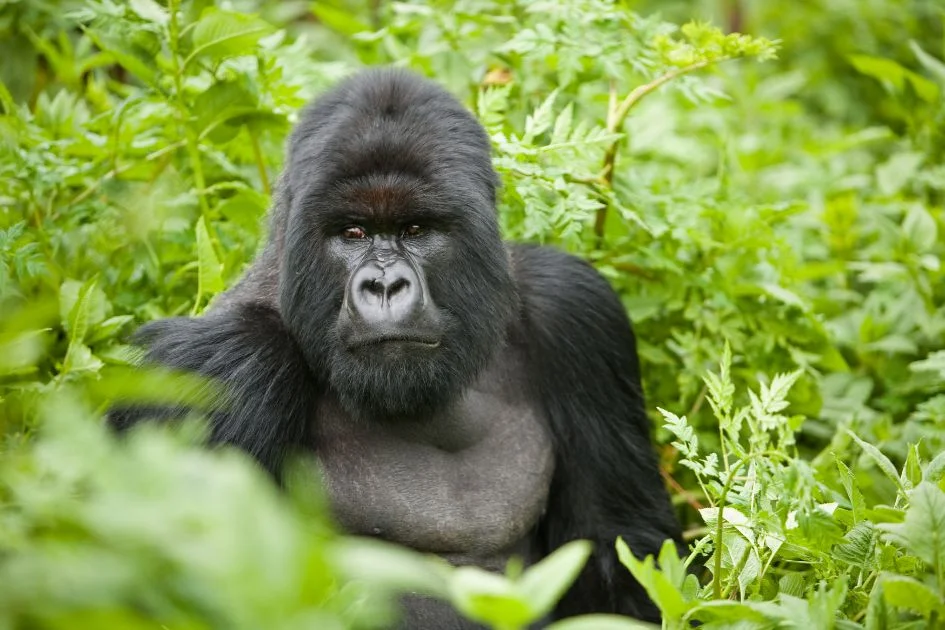
- Scientific Name: Gorilla beringei beringei
- Habitat: Cloud forests
- Range: Africa
- Vulnerabilities: Poaching, habitat loss, civil war,
- IUCN Red List Status: Endangered
The mountain gorilla is a native of Africa, specifically in Rwanda, Uganda, and the Democratic Republic of Congo.
Its natural habitat is a cloud forest, but the current population is limited to just two places.
The first population is in three National parks of Rwanda, Uganda, and the Democratic Republic of Congo.
The second can be found only in Uganda.
The mountain gorilla is classified as endangered by the IUCN, despite it not having many natural predators.
Of course, it is due to human activities. Poaching and habitat loss are the leading cause of population decline. Civil wars also affected the mountain gorilla.
9. Koala

- Scientific Name: Phascolarctos cinereus
- Habitat: Open forests, woodlands
- Range: Australia
- Vulnerabilities: Habitat loss
- IUCN Red List Status: Vulnerable
The koala is sometimes called the koala bear, but that is inaccurate as it is not in the Ursidae family.
It is rather a marsupial and the only living member of the Phascolarctidae family.
Sadly, it is also struggling for survival. The koala is only found in Australia, where its population is reducing.
It is currently classified as vulnerable by the IUCN, and this is so despite it being a symbol in its range.9
Habitat loss is its main problem. The koala inhabits open forests and woodlands which fall victim to deforestation.
10. Lion
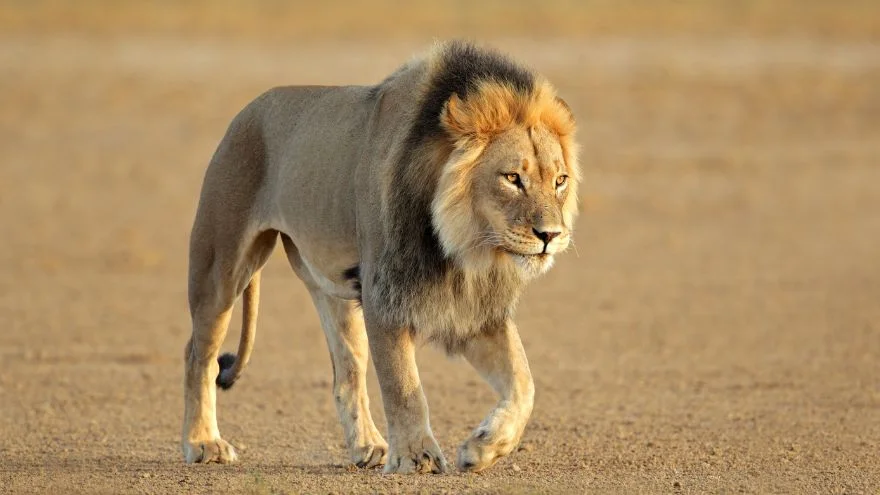
- Scientific Name: Panthera leo
- Habitat: Grasslands, shrublands, savannas
- Range: Africa, Asia
- Vulnerabilities: Poaching, hunting, habitat loss
- IUCN Red List Status: Vulnerable
The lion is a big cat in the Felidae family, a native of both Africa and Asia.
Males are recognized by the mane covering their heads and faces. Females lack the mane but are usually colored brown.
The main habitats of this creature are savannas, grasslands, and shrublands.
Lions are touted as the king of animals because of their apex predatory quality, but that doesn’t curb the population decline it faces.
It is considered vulnerable by the IUCN due to extreme hunting, poaching, and habitat loss caused by deforestation.
Some other big cats, like cheetahs, jaguars, and leopards, are victims.
What Can We Do About Deforestation?
Deforestation is a problem for both animals and humans and because it is caused by us, we have the responsibility of curbing it.
Here are some ways we can do that:
- Recognize that deforestation is tied to the economy, and one way to reduce the obligation to cut trees for economic reasons is to make afforestation a good gain.10
- Plant trees as much as you can.
- Support initiatives put in place to reduce population.
- Raise awareness of the dangers of deforestation in your community. (You can make good use of all you’ve learned in this article.)
Related Questions
Why do we need trees?
Besides aesthetics, fruits, and the cool shelter trees bring, they also reduce carbon dioxide by taking them in and releasing oxygen into the atmosphere. This is both healthy and a good way to combat climate change.
How many animals die from deforestation?
Deforestation is a silent killer, and many animals have been victims as a result. In a year, an estimated 50,000 species get extinct. That is a staggering number.
Does deforestation affect plants?
The first obvious answer is that deforestation reduces the number of plants in the wild. It also affects photosynthesis.
Closing Thoughts
Many human activities have a lot of negative effects on the environment, and deforestation is one such.
With every species that get extinct or becomes endangered due to deforestation, the ecosystem and humans feel the impact.
We all need to actively take steps to reduce the extremities of cutting forests.
References & Notes
- Deforestation and Forest Loss. Our World in Data.
- Deforestation. National Geographic.
- State of the World’s Forests 2020. Food and Agriculture Organization of the United Nations.
- What is genetic diversity? imet.
- The Power of One Tree – The Very Air We Breathe. USDA.
- Overview of Greenhouse Gases. US EPA.
- Chimpanzees. WCS.org.
- Giant pandas no longer endangered but still vulnerable, says China. BBC News.
- Local Environment. Campbelltown City Council.
- Afforestation is an opportunity to create sustainable jobs and mitigate climate change. PWC.






